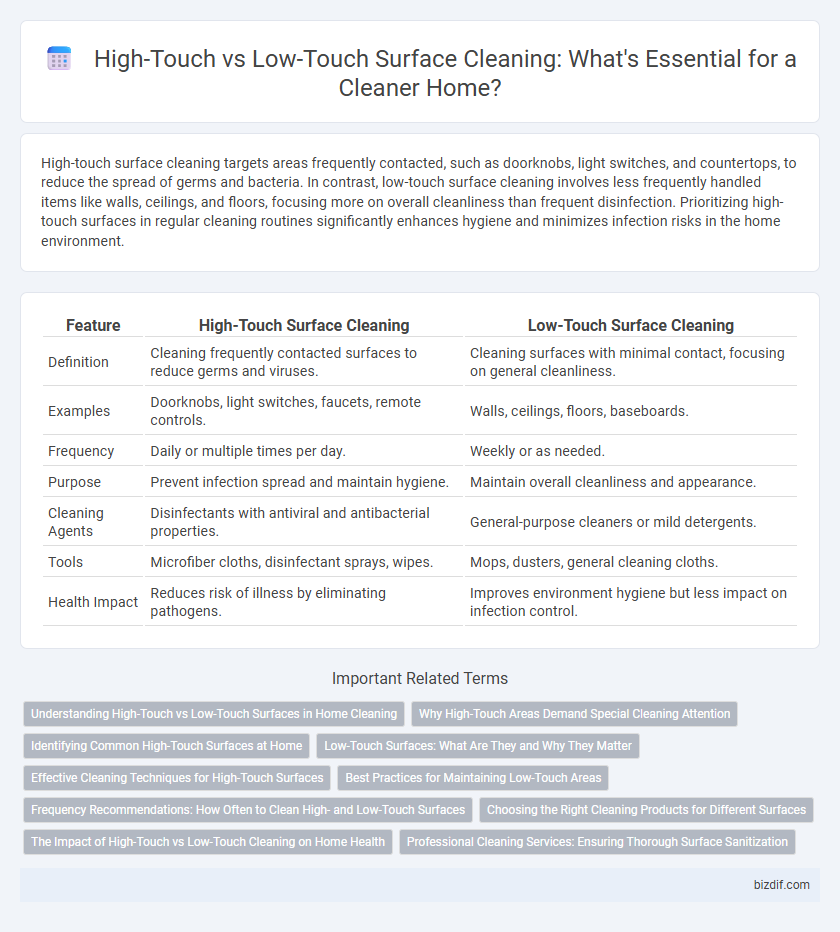High-touch surface cleaning targets areas frequently contacted, such as doorknobs, light switches, and countertops, to reduce the spread of germs and bacteria. In contrast, low-touch surface cleaning involves less frequently handled items like walls, ceilings, and floors, focusing more on overall cleanliness than frequent disinfection. Prioritizing high-touch surfaces in regular cleaning routines significantly enhances hygiene and minimizes infection risks in the home environment.
Table of Comparison
| Feature | High-Touch Surface Cleaning | Low-Touch Surface Cleaning |
|---|---|---|
| Definition | Cleaning frequently contacted surfaces to reduce germs and viruses. | Cleaning surfaces with minimal contact, focusing on general cleanliness. |
| Examples | Doorknobs, light switches, faucets, remote controls. | Walls, ceilings, floors, baseboards. |
| Frequency | Daily or multiple times per day. | Weekly or as needed. |
| Purpose | Prevent infection spread and maintain hygiene. | Maintain overall cleanliness and appearance. |
| Cleaning Agents | Disinfectants with antiviral and antibacterial properties. | General-purpose cleaners or mild detergents. |
| Tools | Microfiber cloths, disinfectant sprays, wipes. | Mops, dusters, general cleaning cloths. |
| Health Impact | Reduces risk of illness by eliminating pathogens. | Improves environment hygiene but less impact on infection control. |
Understanding High-Touch vs Low-Touch Surfaces in Home Cleaning
High-touch surfaces in home cleaning include frequently contacted areas like doorknobs, light switches, and countertops that require regular disinfection to prevent germ buildup. Low-touch surfaces such as walls and ceilings accumulate fewer germs and need less frequent cleaning focused on dust and dirt removal. Prioritizing high-touch surface cleaning enhances hygiene and reduces the risk of illness transmission within the household.
Why High-Touch Areas Demand Special Cleaning Attention
High-touch surfaces such as doorknobs, light switches, and remote controls harbor more germs due to frequent contact and require targeted cleaning to prevent the spread of bacteria and viruses. These areas accumulate oils, dirt, and pathogens that can easily transfer to hands and other surfaces, increasing infection risk. Effective disinfection protocols focused on high-touch zones are crucial in maintaining a healthier and safer home environment.
Identifying Common High-Touch Surfaces at Home
High-touch surfaces in home cleaning include door handles, light switches, faucet handles, and remote controls, which require frequent disinfection due to constant contact. These areas harbor more germs and bacteria compared to low-touch surfaces like walls or ceilings that are rarely touched. Properly identifying and prioritizing high-touch surfaces enhances overall hygiene and reduces the risk of illness transmission within the household.
Low-Touch Surfaces: What Are They and Why They Matter
Low-touch surfaces are areas in a home that are infrequently touched, such as ceilings, walls, or window blinds, and require less frequent cleaning compared to high-touch surfaces like doorknobs or light switches. Despite receiving fewer contacts, regular cleaning of low-touch surfaces prevents dust buildup, mold growth, and allergen accumulation, contributing to overall indoor air quality and a healthier living environment. Maintaining low-touch surfaces is essential for comprehensive home hygiene, reducing long-term maintenance costs, and preventing the spread of airborne contaminants.
Effective Cleaning Techniques for High-Touch Surfaces
Effective cleaning techniques for high-touch surfaces involve using EPA-registered disinfectants with proven efficacy against viruses and bacteria to reduce infection risk. High-touch areas such as doorknobs, light switches, and countertops require frequent cleaning with microfiber cloths and proper dwell time for disinfectants to work efficiently. Emphasizing targeted cleaning routines on these surfaces minimizes cross-contamination and enhances overall home hygiene.
Best Practices for Maintaining Low-Touch Areas
Low-touch surface cleaning involves less frequent but thorough sanitization of areas such as walls, ceilings, and window sills, focusing on preventing dust accumulation and potential allergen buildup. Best practices include using microfiber cloths with mild disinfectants and scheduling cleaning during routine maintenance to maintain overall hygiene without unnecessary wear. Prioritizing these methods helps extend surface lifespan and reduces microbial presence in less frequently handled spaces.
Frequency Recommendations: How Often to Clean High- and Low-Touch Surfaces
High-touch surfaces such as doorknobs, light switches, and countertops should be cleaned daily or after each use to prevent the spread of germs and maintain a hygienic home environment. Low-touch surfaces like walls, ceilings, and storage shelves require cleaning only every few weeks or monthly, depending on dust accumulation and household activity. Following these frequency recommendations ensures effective prioritization of cleaning efforts for optimal health and cleanliness.
Choosing the Right Cleaning Products for Different Surfaces
Effective home cleaning requires selecting the appropriate cleaning products for high-touch surfaces such as doorknobs and light switches, which benefit from disinfectants containing EPA-approved ingredients to eliminate germs and bacteria. Low-touch surfaces like walls and ceilings typically need milder cleaners, such as all-purpose sprays or gentle detergents, to avoid damage while removing dust and dirt. Understanding the surface material--whether wood, glass, or metal--ensures the use of compatible products that maintain cleanliness without compromising surface integrity.
The Impact of High-Touch vs Low-Touch Cleaning on Home Health
High-touch surface cleaning targets frequently contacted areas such as doorknobs, light switches, and countertops, significantly reducing the spread of pathogens and allergens that contribute to home illness. Low-touch surface cleaning focuses on areas with minimal contact, which, while less critical for immediate health risks, helps maintain overall home cleanliness and reduces dust accumulation. Prioritizing high-touch surfaces in cleaning routines enhances indoor air quality and lowers infection rates, creating a healthier living environment.
Professional Cleaning Services: Ensuring Thorough Surface Sanitization
Professional cleaning services prioritize high-touch surface cleaning to target frequently contacted areas like doorknobs, light switches, and countertops, reducing the risk of germ transmission effectively. Low-touch surface cleaning focuses on less frequently contacted spots such as walls or ceilings, maintaining overall cleanliness but with less urgency. Ensuring thorough surface sanitization, expert cleaners utilize specialized disinfectants and techniques to address both high- and low-touch surfaces, promoting a healthier home environment.
High-Touch Surface Cleaning vs Low-Touch Surface Cleaning Infographic

 bizdif.com
bizdif.com